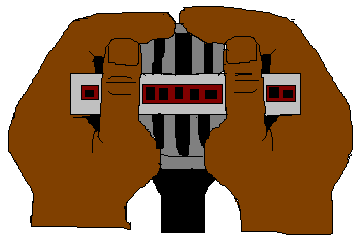Holding a Bullet Microphone
The Grip
There are two considerations for using a bullet type mic with a harmonica. These are 1) keeping the harp from banging against the mic and 2) getting a good airtight seal.
The hands should be open and cupped like the Allstate good hands commercial. The mic should set in the cupped hands and your hands will close onto the mic. The back of the mic might have to stick out between your hands in the back if you have normal sized hands. If you have big hands, you have an immediate advantage. You thumbs should be up in the air. The harp lays across your hands and your thumbs come down to hold it in place. The back of the harp should be about 1/4 inch away from the mic. The flesh in you hand at the base of the thumbs should be able to hold the harp away from the mic. At this point the mic might have to be adjusted back so the back sticks out between your hands.
 fig
1. How to grip the harp and mic.
fig
1. How to grip the harp and mic.
If you got it right, the harp won't touch the mic. You will have to adjust the harp to position the lower end of the scale for typical playing. If you are doing some first position and want to switch between low end and high end Jimmy Reed stuff, you will have to work out some strategies to move the harp fast from one end to the other.
Once you can play the harp comfortably without making noises with the harp against the microphone you will need to get a good airtight grip. The JT30 needs lots of volume in to get a good sound. You can't make the mic loud enough to play without a good grip. Turning up the volume will just cause the mic to squeal. Once you get a good grip, it takes surprisingly little air flow to get a good sound.
Grip the mic tightly with the fingers overlapping in the back. The harp should almost hurt as it is drawn against the hand. If the harp touches the mic then adjust the mic back. it should feel as if you are trying to squirt the mic back out between your hands. Blow or draw the harp. If you did it right you can feel the force of your lungs push and pull on the flesh of your hands. The sound of the harp will be very muted and horn like. Experiment until you can feel the air tightness of the grip. You can't help but get some leakage, but you will be able to feel where the air is getting in and out of your grip you can adjust your hands to limit this.
Next you need to be able to do a "whah" sound. There are two ways to do this and the chief problem is to get you hands back again to the good seal when you finish. One of you hands is probably overlapping the other hand in the back top side of the mic. Lift this hand to release the seal of your grip. This will take away the mute sound. Do not release the tightness of your grip on the mic and the harp. You want all of the air passing though the harp to impact the face of the mic. The mic still has a problem that the volume into the mic has to be loud and you are letting some out. Don't loose your grip. You can now make whah-whah sounds by gripping and ungripping with the hand on top. The draw back is that you can loose you grip. On the plus side it looks good. There are lots of harp players that make the whah with their mouth. It's easy to do, although not as strong as the hand whah. They move their hands for effect. James Cotton exaggerates his hand motions to emphasize his whah's, but I believe much of it is in his incredible control of the harp tone with his mouth. The hand motions are mostly for show. Cotton does gets incredible vacuum when he draws with a good grip. I have heard the story, which has been retold often, of how he has collapsed the steel covers on marine bands with his breath.
There is another, perhaps better, way to release the seal and get a whah sound. When you have a good grip the heels of your hands near the wrist are pressing tight against each other. If you lift your elbows the hands will naturally separate leaving a gap for the sound to escape. This works with or without a mic. This has the advantage that you never loose your tight grip on the mic. It has the disadvantage that it feels (and looks) kind of geeky. You get that "chicken flapping his wings" look. In a music where "cool" is extremely important this can blow the image for a blues harper. If you are going for a good sound, and don't care what you look like, then use this method. (personally, I am so un-cool that flapping my wings can't make me look worse.)
All in all, using a bullet mic with the harp is always going to look like you are jamming a small rodent down your throat. I would concentrate on getting the good seal and maintaining it. If your harp hits the mic sometimes that is not too bad. Use the chicken flap method to whah unless you are insecure in your coolness. Otherwise I would not use both hands to whah, that is only for show. Use the one hand to open up and close the seal so that you do not loose the tight grip.
